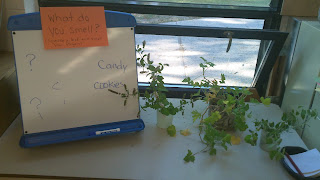The
Theory:
The Ontario curriculum, as would be true of many around the world,
speaks of inquiry as being ‘at the heart of learning in all subjects.’ Research
suggests that students are more likely to develop as engaged, self-directed learners
in inquiry-based classrooms (Jang, Reeve & Deci, 2010; NCREL online). In the Ontario Early Learning Full Day Kindergarten Program (Draft version 2010), the word “inquiry” is used 39 times, and refers to inquiries by students AND educators. Thinking about what inquiry means to me (an evolving thought!), has been
leading a lot of my ‘rethinking’ of kindergarten. As educators, we are constantly in the centre
of the maelstrom as we launch multiple inquiries through observing
children, adding provocations into the environment, and seeing what develops.
The document tells us that just natural curiosity
on the part of children is not enough. Four basic stages of the inquiry process
are recognized (seen also in many other professional references to
inquiry-based learning): initial engagement, exploration, investigation and communication.
Our role is to gradually guide the children to become more focused and
systematic in their observations and investigations. (This would seem to
pertain to ourselves as the educators as well as the children!)
The
Practical:
We began our own inquiry into ‘inquiry in a
Kindergarten classroom’ with this quote from the Ontario document in mind:
Children
learn best when dealing with topics they can explore directly and in depth.
Abstract topics (e.g., rainforests, penguins, planets) are difficult for
children to conceptualize. The topic of any
inquiry should be drawn from things that are familiar to children in their
daily lives.
Three months into the year, this is what that
has meant for us so far…
We started with the encouragement to observe
more closely in very small ways at the Discovery Centre, putting out materials
such as multi-headed black-eyed susans, a variety of herbs, cut up vegetables, things the students
brought in… with magnifying glasses and a question. We encouraged them to use
their senses and modeled recording their thinking.
Our first bigger inquiry was launched by one of
the children who brought in gourds from his organic farm. Most of the children
did not know what they were. This led to great questions (“Is it a
banana, pineapple? What does it look like inside?”) and the start of some
investigation as we cut them open. We also learned that we could gain
information from experts, books, videos and through our investigations and observations.
This was the first inquiry that we went public with.
The most challenging part of our professional learning curve
with this so far has been how to effectively go public. I confess that I tried
to make it all look ‘pretty’ by putting the learning into a powerpoint that
we could watch, and print out for the wall (later to become a classroom book).
While the children’s questions, words, photos and ideas were captured, it didn’t
seem as relevant to them in this form.
One of our EA’s brought in a “Skinny Pig” (a
hairless guinea pig) that we introduced with the question, “What is it?” The
students used their senses (except taste!) to create theories for
what this animal might be. Here we began to see the emergence of representations
of their thinking that went into the next book about our learning.
From there we thought we could provoke some more
investigation and theories with some non-working electronic pieces (e.g. an answering
machine) at a centre that we called “What’s Inside?” We put out
tools, did some learning on safety, and watched what unfolded. We recorded what
they noticed through quotes and photos. Next they represented their thinking
about what they would find in a clock radio. Their theories included wires,
plastic parts, etc… as well as Super Mario, worms… Later reviewing their theories in comparison with
their findings, led to more grounded theories for the next items, a couple of
defunct phones they are starting to deconstruct next week.
We are also getting smarter now… we will ask
the students how they think we should all share what we have learned! This may
mean giving up control of the camera and the ‘prettiness!’
Side note… while this blog reflected more ‘science-based’
inquiries, we have also been taking this approach in other learning areas, for
example with the great math question, “How tall is Ms. M?” (“46,” “30 pounds,” “longer
than my arm,” “shorter than two students”… LOL). More to come as we continue to
learn and evolve in our professional understanding!
Resources:
Full Day Early Learning Kindergarten Program, Draft 2010 – p. 14-16
Capacity Building Series: Getting Started With
Student Inquiry
Video: Kindergarten Matters: “It’s About Inquiry”










